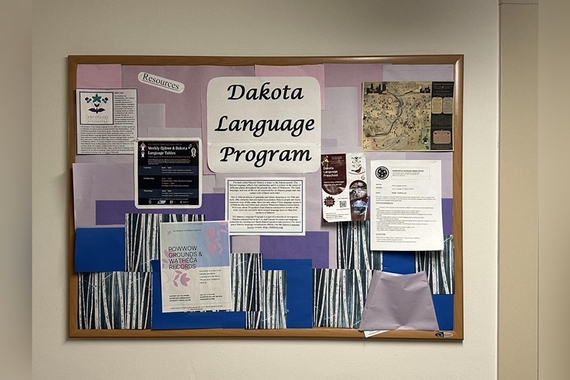Cherish the Language: Investing in Dakota at UMN
“If we cherish the Dakota language, and we cherish the Dakota people, then we will cherish the land, and also the Dakota way of life,” says Šišóka, a teaching specialist in the Department of American Indian Studies (AIS). With heritage and legacy in mind, the AIS department takes action with the growing enrollment in the Dakota language program and a new Dakota language major as part of Minnesota Transform, a $5 million higher education initiative funded by the Mellon Foundation.
In Good Hands
Enrollment in the Dakota language program has soared since it took on an online format four years ago—long before the pandemic. From 40 to 150 students, Dakota courses have seen faces from in and out of Minnesota.
“The Dakota people have moved around,” Šišóka points out, “and we have a huge geographical area where we’ve lived historically. Some of our people live in Canada. Technically, it makes us an international class.”
Thanks to the increase in enrollment, a new bachelor of arts degree in Dakota language launched this fall. Not just about language, the major features courses in Dakota culture, politics, history, literature, art, and more. “Perhaps the most important thing about the approval of the BA degree,” says Vicente Diaz, chair of AIS, “is that it helps elevate the importance and significance of formal study of Dakota life to the mission of the University of Minnesota, which is, as we know, built upon unceded Dakota homelands and waters.”
Long-time instructors such as Šišóka, a pivotal figure for the Dakota community at the UMN, have raised and guided the next generation of Dakota speakers for years. Whether it was for finding their identity, culture, or purpose, students enroll in the Dakota language program looking for something more, and often find a long-standing legacy in their search.
“As you get older,” Šišóka speculates, “you have to start thinking about training the next generation to do the work that you’re not going to finish. Not everyone is going to be a teacher or an activist—but that’s okay. Learning the language is still advocacy; we know the language is in good hands when we’re not here.”
Language is Home
The AIS department received support from the Mellon Foundation as part of Minnesota Transform, a “major higher education initiative engaging anti-colonial and racial justice work” at the University of Minnesota. The funding would prove fruitful for aspiring learners of Dakota and Ojibwe, with ninety percent of their total fees and tuition supported by the grant. It also helps establish a new tool for future Dakota speakers to come: the Dakota Audio Journal.
“One of the problems we have to overcome as people who didn’t grow up speaking the Dakota language,” Šišóka states, “is that we sound like English speakers. And Dakota people have a different accent.” As the number of fluent Dakota speakers dwindles in Minnesota, a worry for the loss of the Dakota accent becomes prevalent. To learn a language in a classroom is one thing, but to hear, speak, and listen to the language in its most authentic form at home is another. “Younger people come to the University, they learn here, and then they try to talk and it sounds like they're speaking from a book,” Šišóka says, “and there’s nothing you can really do about it, because classrooms are a constructed setting.”
The Dakota Audio Journal opens the opportunity for students to hear the Dakota language as it is spoken by the few remaining fluent elder speakers left in the community. “In the future, there won’t be any fluent speakers,” Šišóka says, “they’ll be gone at one point, and so how will we hear this accent, or how they put things together? That’s the overall vision of this project: to make our language accessible to us.” Šišóka, along with Dakota Language Documentation Journalist Raine Cloud as the supervisor and their three interns, Nicole Subola, Eric DuMarce, and Justis Brokenrope, work together to bring the project to life.
Language connects us, not just in the present, but in the past and the future as well. It bypasses time entirely. And for some people, language is home. “Once you start learning a language,” Šišóka says, “you learn about the culture and the people—how they live and what they like. That’s why it’s so important to keep our traditional language alive.”
A History Unforgotten
There’s a long history of injustice and exploitation between higher education institutions and the Dakota people. “They stole the cultural and intellectual property [of the Dakota people], and made a name for themselves without giving back to the community,” Šišóka says. “They used to dig up our bodies and keep them inside their archives.” It’s a history that can’t be forgotten, and land acknowledgments can only go so far.
“A lot of people still remember that [mistreatment],” Šišóka says. “And so, that distrust still lingers.”
So what can be done? “More,” Šišóka answers. “Let’s license Dakota teachers. Let’s offer as many classes as we can. Let’s partner with other people to do more. To all the non-Dakota people out there, take a class. And for Dakota people, this language belongs to you. It’s your birthright. If you don’t learn it, who will?”
With the Mellon Foundation grant, students can learn the Dakota and Ojibwe languages nearly tuition-free, and the Dakota Audio Journal will immortalize the language for generations to come. It’s one step toward the reconstruction of trust between universities and the Dakota people; a bridge that only grows sturdier as we do more.
This story was written by an undergraduate student in CLA


